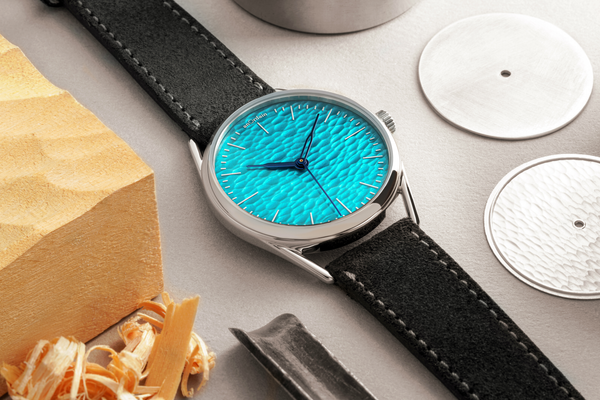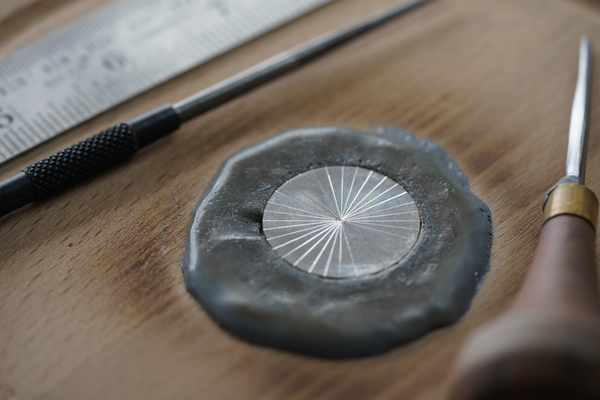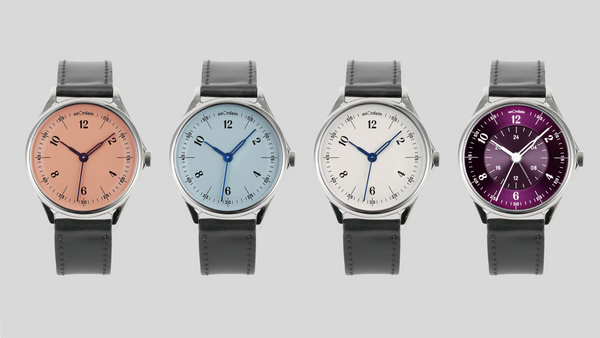Case Engraving Now Available
September 02, 2019
The Model 2 features a solid case back which, as well as enabling a slimmer profile, opens up the possibility of custom engraving.
Until recently all of the text on our cases had been applied using acid etching by the case manufacturer. However, in order to customise the case back, we've needed to begin exploring other engraving methods.
We initially looked into laser engraving but we felt that the finish, although very accurate, is too shallow and lacks the character you get with old engravings on vintage watches (which we later discovered was due to the use of mechanical engraving). A 2mm thick solid case back, like that of the Model 2, offers the chance to engrave much deeper.
Having acquired a machine engraver we began testing carbide and diamond tip drag engravers which produced some precise and elegant results. We felt that it lent itself well to handwritten engraving and really shone when light caught the surface.
Although this was an attractive finish we still felt that it wasn’t quite right and so continued to experiment with different tools and began exploring different depths. When engraving small details, machine tolerances, feeds and speeds are all important.
We tried to mill out details using 0.6mm end mills and cutting fluid but this often resulted in the shearing of tools. Whilst researching we noticed that a consistent legibility seemed to be achieved with crisp cut lines and a 0.2-0.4mm depth of cut. With the drag engravers only achieving a 0.1mm cut we moved to V-Shape cutters that would remove material more noticeably and cut to a depth instead of simply scoring.
With a 0.2mm cut successfully achieved we began to design jigs that would hold the watch case securely in place during each cut. Having access to 3D printing facilities on site meant that we could easily customise each jig to fit specific models and clamping equipment. We have now standardised alignment to ensure a consistent finish and quality.
 Above: Our 3D printed jigs, which we developed to enable custom case back engraving. Many of the jigs we use in dial production were also 3D printed in our studio - this method enables us to make quick adjustments and refinements without delays to production.
Above: Our 3D printed jigs, which we developed to enable custom case back engraving. Many of the jigs we use in dial production were also 3D printed in our studio - this method enables us to make quick adjustments and refinements without delays to production.
A New Font
Initially we experimented with a range of different fonts to determine which would perform best at the scale of the engraving, and with the limitations of the various tips.
In the end we decided to develop a new version of our own ‘Maps’ font to suit the engraving process - one of the luxuries of having a typographer in house! It was designed originally to be legible and yet still full of character, taking inspiration from fonts used commonly on maps. We used this typeface for our minute markings on the Model 1. It has a uniform line width and therefore is the perfect choice for a process which uses single line tool paths.
 Above: The development of the typeface Maps, in which the letterforms were individually designed to suit machine engraving at small sizes.
Above: The development of the typeface Maps, in which the letterforms were individually designed to suit machine engraving at small sizes.
This mechanical engraving process does lead to burring and therefore once the cut is complete, we run it a second time. This removes some of the burr but sanding is still necessary to tidy up the finish.
Depending on the case finish, we then re-polish or sand-blast the case back accordingly.
 Above: Polishing in progress
Above: Polishing in progress
Engraving is available as a free service with all Model 2 purchases - simply click "add engraving" whilst on the product page.


